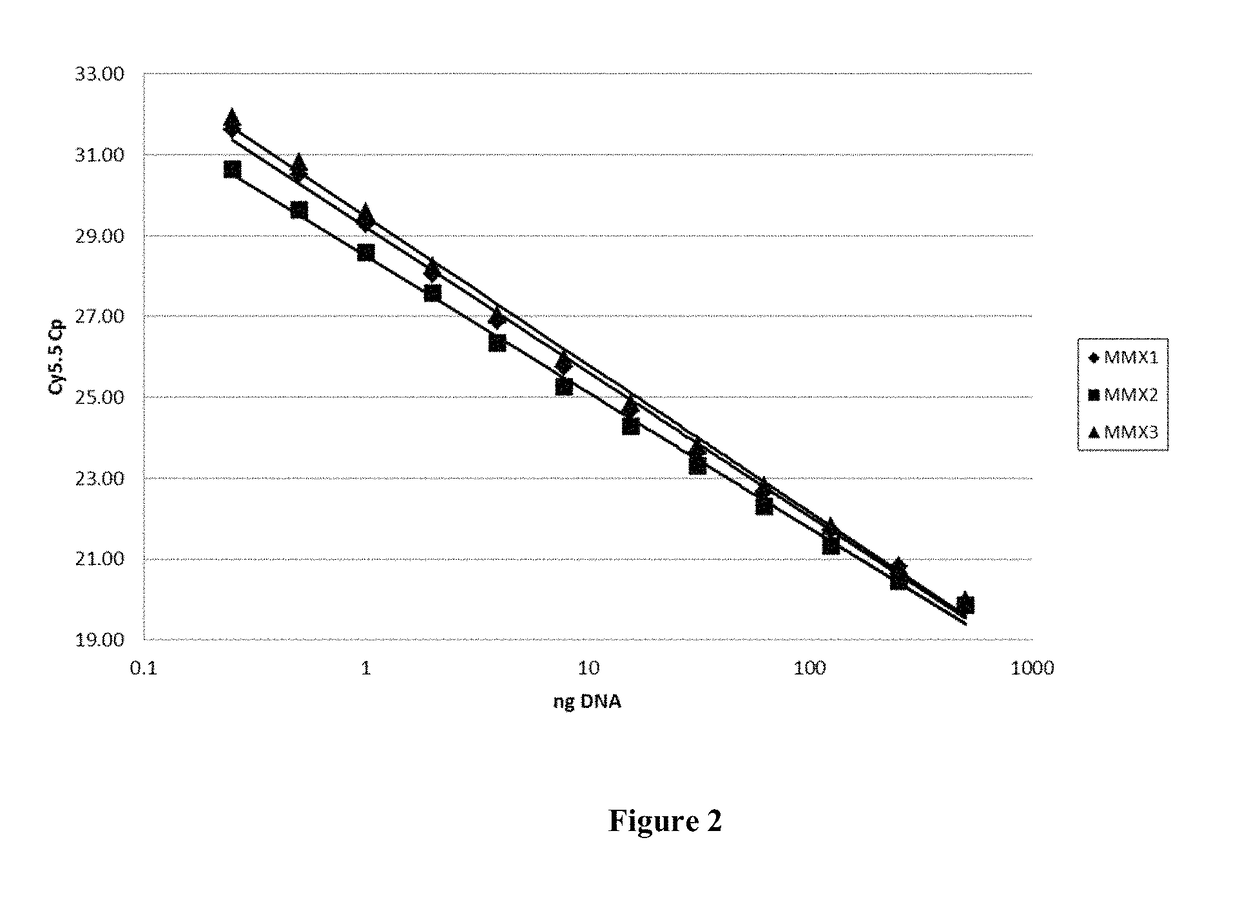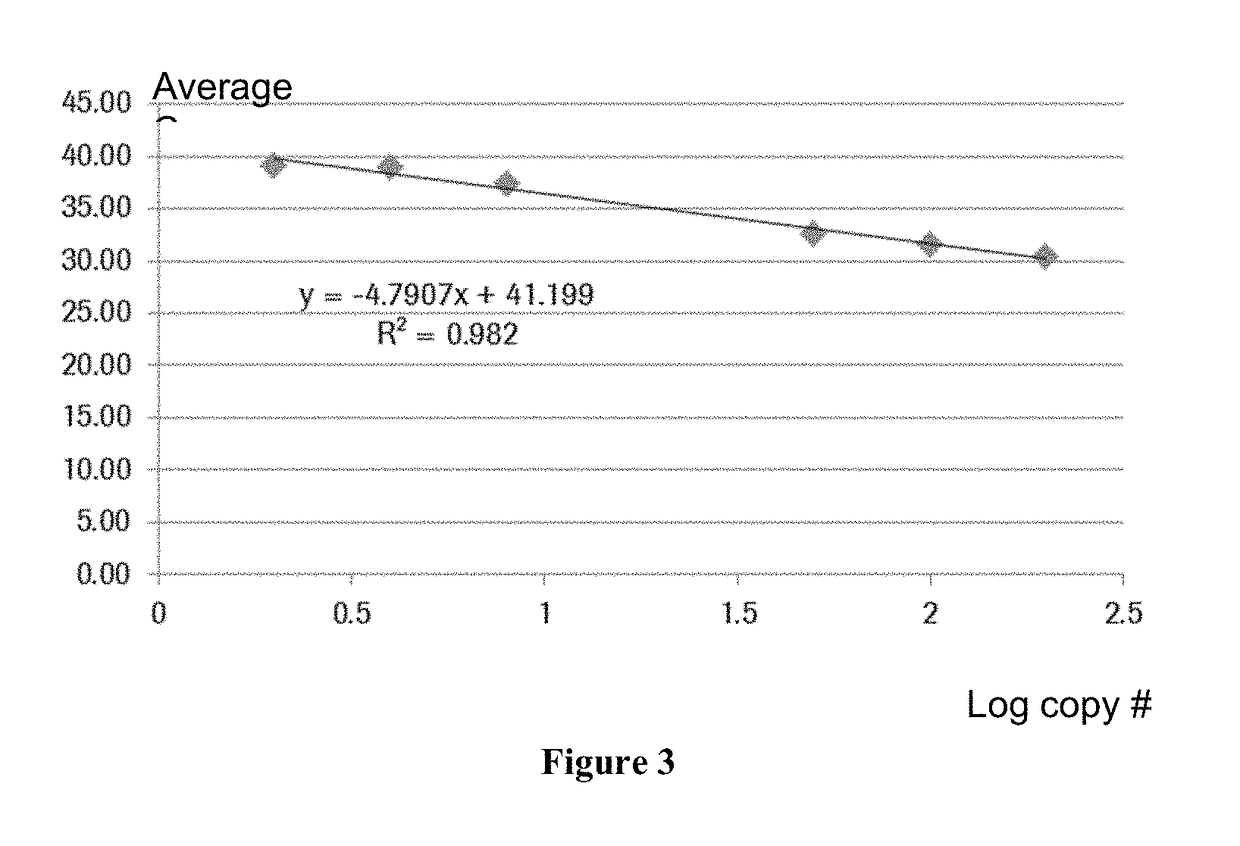Mutation testing
a technology of mutation testing and mutation, applied in the field of mutation testing, can solve the problems of difficult diagnosis of nsclc, drug effectiveness in the majority, and the need to change the course of treatment, so as to reduce the pain, improve the disease, and reduce the size of the tumor
- Summary
- Abstract
- Description
- Claims
- Application Information
AI Technical Summary
Benefits of technology
Problems solved by technology
Method used
Image
Examples
example 1
Isolation of Nucleic Acids and PCR Amplification
[0110]All the samples were acquired from lung cancer (NSCLC) patients. Nucleic acid isolation was performed utilizing COBAS® DNA Sample Preparation Kit (Roche Molecular Diagnostics, Indianapolis, Ind.) according to the manufacturer's instructions. Real-time alleles-specific PCR amplification was performed on a COBAS® instrument using COBAS® EGFR Mutation Test kit (Roche Molecular Diagnostics) according to the manufacturer's instructions. Briefly, the COBAS® kit contains three reaction mixtures, MMX1, MMX2, and MMX3, for allele-specific real-time PCR detecting various mutations in the human EGFR gene. MMX1 comprises primers and 6-carboxyfluorescein (FAM)-labeled probes for multiple deletions in exon 19 of the human EGFR gene (termed Ex19Del) and substitution mutation S768I (JA270 signal). MMX2 comprises primers and probes for substitution mutation L858R (FAM signal) and mutation T790M (JA270 signal). MMX3 comprises primers and probes fo...
example 2
Establishing a Calibration Curve for the Quantification of DNA Targets
[0111]To calibrate the assay, varying amounts of genomic DNA were subjected to real-time PCR amplification using the COBAS® EGFR Mutation Test kit. Twelve levels of genomic DNA were tested: 0.25, 0.5, 1, 2, 4, 8, 16, 32, 64, 125, 250 and 500 ng / reaction. At each genomic DNA level, 120 replicate PCR assays were run with internal control (IC) primers and probes in three different multiplex PCR reaction mixtures included in the kit (MMX1, 2 and 3, see Example 1). The resulting standard curve is shown in FIG. 2. On FIG. 2, the X-axis represents genomic DNA level and the Y-axis represents cycle number corresponding to the cross point (Cp) achieved in the reaction. Based on the experimental data illustrated by FIG. 2, the valid range of the internal control values (IC Cp range) was set at 20-32. In the selected valid Cp range, assay linearity was observed for all the reaction mixtures tested.
example 3
Establishing a Cut-Off Limit for the Quantitative PCR Assay
[0112]For each reaction mixture, a measurable range within the valid IC Cp range was established using the data from non-specific amplification in the absence of the true target occurring at later cycles of PCR, which was termed “breakthrough amplification.” For each reaction mixture, breakthrough amplification was observed with at least one set of primers and probes. For each target within each reaction mixture, the value of CpR was determined, which was the difference between the internal control signal and the breakthrough signal, calculated as the difference between breakthrough Cp and internal control Cp observed in the same reaction. For example, for Ex19del target (illustrated in Table 2), breakthrough occurred at the higher levels of genomic DNA tested, but CpR was consistently high at these levels. The minimum CpR observed was selected as a cut-off value. The target Ex19del signal was considered positive (mutation d...
PUM
| Property | Measurement | Unit |
|---|---|---|
| time | aaaaa | aaaaa |
| real time PCR | aaaaa | aaaaa |
| PCR cycle threshold | aaaaa | aaaaa |
Abstract
Description
Claims
Application Information
 Login to View More
Login to View More - R&D
- Intellectual Property
- Life Sciences
- Materials
- Tech Scout
- Unparalleled Data Quality
- Higher Quality Content
- 60% Fewer Hallucinations
Browse by: Latest US Patents, China's latest patents, Technical Efficacy Thesaurus, Application Domain, Technology Topic, Popular Technical Reports.
© 2025 PatSnap. All rights reserved.Legal|Privacy policy|Modern Slavery Act Transparency Statement|Sitemap|About US| Contact US: help@patsnap.com



